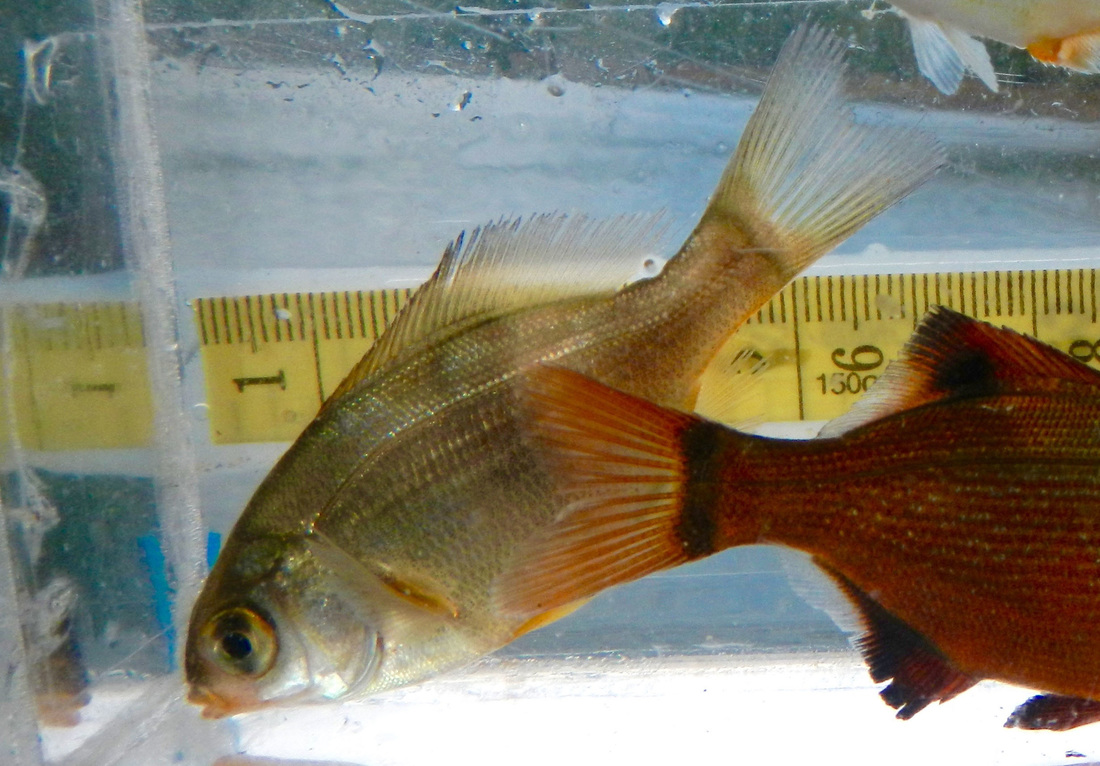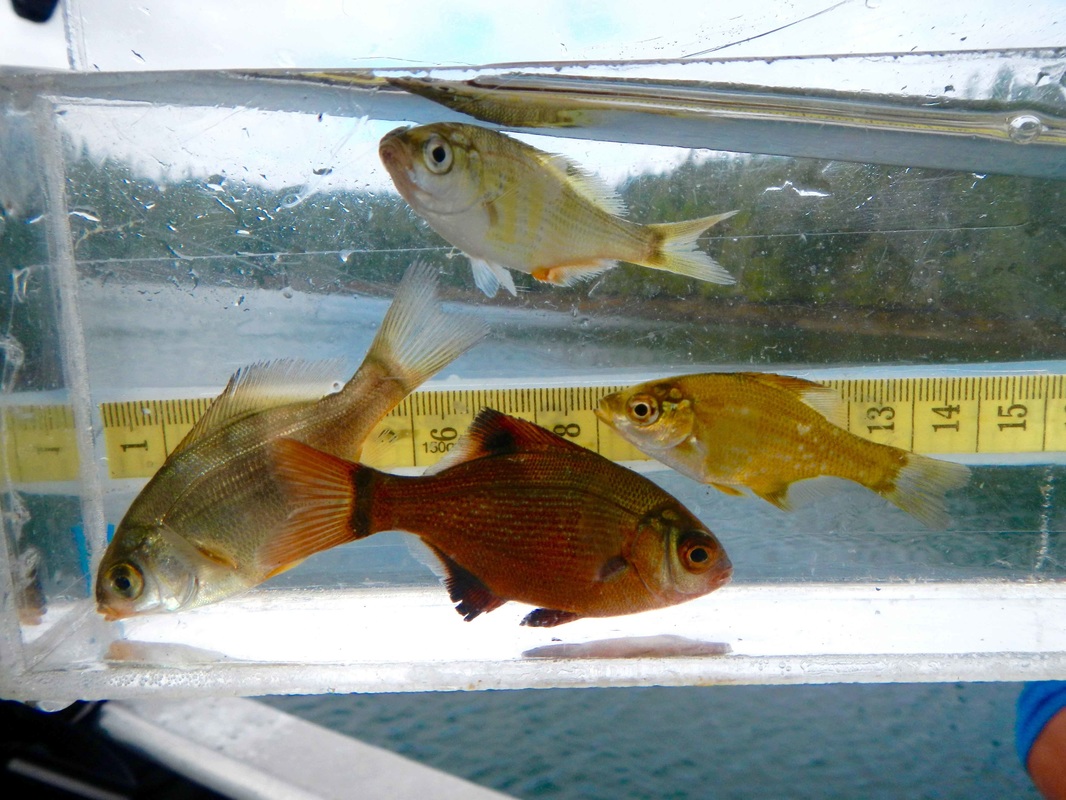Pile perch • Rhacochilus vacca, Damalichthys vacca
Left: juvenile pile perch. Right: the whole image, showing the juvenile pile perch alongside a juvenile shiner perch (top), juvenile kelp perch (right), and juvenile striped seaperch (bottom). Photo by the Hakai Institute FABS (Fish Assemblage Beach Seining) team.
Identification
This surfperch is silvery with indistinct bands or patches of dark grey or brown, and darker along the back than on the sides and belly. It has a deeply forked tail fin, and the front (spinous) section of its dorsal fin is lower than the back (rayed) part. Like other surfperches the pile perch has a deep, laterally compressed body. It gets to about 45 cm long.
Habitat & Range
The pile perch tends to occur along rocky shorelines, particularly in areas that have some structure underwater such as kelp forests, rocky reefs, and pilings. It is found in the subtidal to depths of at least 46 m; Lamb and Hanby put its maximum depth at 80 m. It has been recorded from southeastern Alaska to central Baja California.
Similar Species
The only other surfperch found on the Central Coast that lacks distinct barring (redtail surfperch, shiner perch) or stripes (striped seaperch) is the kelp perch, which is brown (often coppery) and more uniform in colour.
Human Uses
The pile perch is caught for food by recreational harvesters and in small amounts by commercial trawlers. It is also caught for use in aquariums.
Intriguing Info
While declines in pile perch numbers have been observed off the coast of California in recent decades, it is still considered abundant and is listed as "Least Concern" by the IUCN.
iNaturalist
https://www.inaturalist.org/taxa/111616-Rhacochilus-vacca
This surfperch is silvery with indistinct bands or patches of dark grey or brown, and darker along the back than on the sides and belly. It has a deeply forked tail fin, and the front (spinous) section of its dorsal fin is lower than the back (rayed) part. Like other surfperches the pile perch has a deep, laterally compressed body. It gets to about 45 cm long.
Habitat & Range
The pile perch tends to occur along rocky shorelines, particularly in areas that have some structure underwater such as kelp forests, rocky reefs, and pilings. It is found in the subtidal to depths of at least 46 m; Lamb and Hanby put its maximum depth at 80 m. It has been recorded from southeastern Alaska to central Baja California.
Similar Species
The only other surfperch found on the Central Coast that lacks distinct barring (redtail surfperch, shiner perch) or stripes (striped seaperch) is the kelp perch, which is brown (often coppery) and more uniform in colour.
Human Uses
The pile perch is caught for food by recreational harvesters and in small amounts by commercial trawlers. It is also caught for use in aquariums.
Intriguing Info
While declines in pile perch numbers have been observed off the coast of California in recent decades, it is still considered abundant and is listed as "Least Concern" by the IUCN.
iNaturalist
https://www.inaturalist.org/taxa/111616-Rhacochilus-vacca
References
Froese, R. and Luna, S. M. Rhacochilus vacca (Girard, 1855) Pile perch. FishBase. Accessed 18/08/2016.
Lamb, A. and Edgell, P. Coastal Fishes of the Pacific Northwest. Revised. (2010). Madeira Park, BC: Harbour Publishing. Pp. 92-93.
Lamb, A., and Hanby, B. (2005). Marine Life of the Pacific Northwest [electronic version]. Madeira Park, BC: Harbour Publishing.
Starnes, W.C. (2010). Rhacochilus vacca. The IUCN Red List of Threatened Species 2010. International Union for the Conservation of Nature and Natural Resources. Accessed 18/08/2016.
Authors and editors of page
Kelly Fretwell (2016).
Froese, R. and Luna, S. M. Rhacochilus vacca (Girard, 1855) Pile perch. FishBase. Accessed 18/08/2016.
Lamb, A. and Edgell, P. Coastal Fishes of the Pacific Northwest. Revised. (2010). Madeira Park, BC: Harbour Publishing. Pp. 92-93.
Lamb, A., and Hanby, B. (2005). Marine Life of the Pacific Northwest [electronic version]. Madeira Park, BC: Harbour Publishing.
Starnes, W.C. (2010). Rhacochilus vacca. The IUCN Red List of Threatened Species 2010. International Union for the Conservation of Nature and Natural Resources. Accessed 18/08/2016.
Authors and editors of page
Kelly Fretwell (2016).






